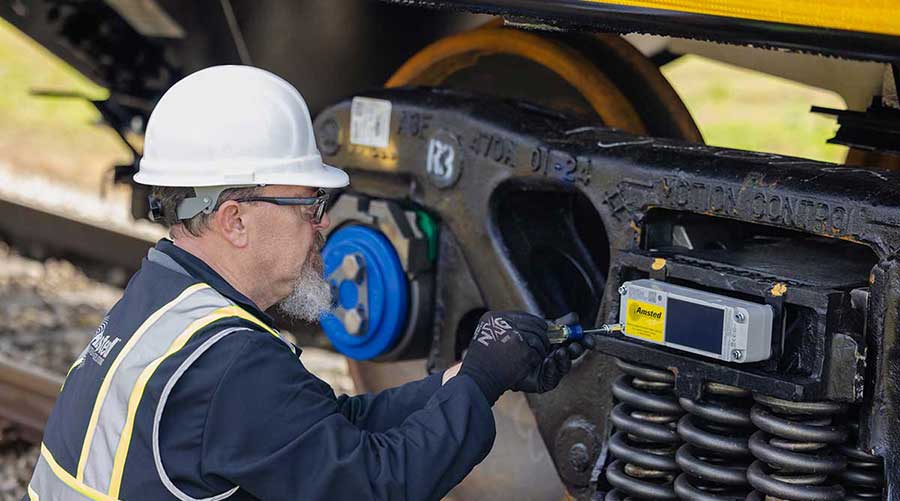Stay updated on news, articles and information for the rail industry
January 2013
Rail News: Rail Industry Trends
Marcellus and Utica shale drilling keeps railroads busy
— by Julie Sneider, assistant editor
The drop in natural gas prices in 2012 may have slowed the pace of drilling in some areas of the Marcellus Shale, but shale plays remain growth drivers for Class Is and short lines serving the eastern United States.
A warm winter last year combined with rapid expansion of energy companies' drilling across the Marcellus region helped keep a lid on natural gas prices, particularly for "dry" natural gas (methane). As a result, energy companies have widened their focus from the dry gas areas of central and northeastern Pennsylvania to the "wet" gas (ethane, propane, butane) territories in the state's western region and into the Utica Shale in Ohio.
Railroads that operate in the Marcellus and Utica shales remain busy transporting frac sand, pipe, chemicals and other commodities needed for shale exploration and drilling. Despite the lull in some parts of the Marcellus, railroad officials expect shales to remain one of their fastest growing lines of business in 2013.
"The southwestern part of the Marcellus, which goes into southwestern Pennsylvania and West Virginia, continues to be fairly strong," says Rob Robinson, assistant vice president of short-line and commercial development at Norfolk Southern Railway.
NS officials anticipate activity will pick up again in the dry gas Marcellus territory when the price of natural gas moves back up. In the meantime, NS remains busy moving carloads of frac sand and other shale-related supplies.
"Through July, we were still up about 40 percent over 2011," Robinson says of NS' 2012 Marcellus traffic. Then, the Class I saw August and September drop off "pretty significantly" before posting a "slight resurgence" of traffic in October.
"We are somewhat hopeful that we'll finish [2012] strong — I think that will be up 30 to 40 percent over last year," says Robinson. "But last year [2011], we were up 100 percent from 2010."
Frac sand represents 70 percent to 75 percent of the materials NS moves into the Marcellus.
Shale play development in the eastern United States will continue and, in turn, keep providing growth opportunities for North American railroads, rail executives and industry analysts say.
U.S. carloads of petroleum and related products posted a "whopping 48 percent year-over-year growth" in second-quarter 2012 and a 47 percent year-over-year gain in July 2012, according to an August 2012 report on the financial analysis website Trefis.com. When it comes to the Marcellus and Utica, CSX Transportation and NS are in a good position to take advantage of business there, the Trefis report stated.
The report also noted how the railroads have been gearing up for the shale business, spending heavily on special freight cars specifically designed for moving frac sand. CSXT, for example, purchased about 900 cube hoppers for transporting the sand in 2011, and NS allocated nearly 14 percent of its 2012 capital expenditure budget for sand-transporting cars, according to the report.
Canadian Pacific's Shale Business Growing
Canadian Pacific, too, is trying to take advantage of shale development opportunities. The increasing sand volume prompted by drilling in North American shale plays is a key component of CP's energy sector growth strategy, says spokesman Ed Greenberg.
"We're not only moving sand into regions like the Bakken Shale for oil drilling, but with our network capabilities, we're moving inbound materials like sand to the Marcellus Shale and through our strategic connections to the Utica Shale" for natural gas drilling, Greenberg says.
Any slowdown in frac sand carloads moving into the Marcellus in 2012 was offset by demand for sand in other shale plays in Texas, North Dakota and Canada, he says. When natural gas prices start to increase, CP will be ready to take advantage of the opportunity, Greenberg adds.
Meanwhile, activity in the Utica Shale in Ohio is gaining momentum. Twenty-eight rigs were active in the Utica during the last week of October 2012, up from 15 a year earlier. That compares with 88 active rigs in the Marcellus Shale play, a decline of 53 active rigs versus October 2011, according to a U.S. Energy Information Administration (EIA) report issued in November.
"Utica in 2012 is where Marcellus was in about 2008," says NS' Robinson. "You'll see somewhere around 200 wells drilled [in 2012], which is a relatively small number. But in 2013, that number triples and you'll see between 600 and 650, and by 2014, we expect that number to be 1,800 to 2,000 wells."
Much of the current Utica activity is occurring in the Ohio counties of Carroll, Jefferson, Harrison, Columbiana and Noble, says Jim Schaaf, NS' group vice president-metals and construction.
As the Utica activity ramps up, NS is "working diligently" to make sure it has multi-commodity facilities that can handle inbound cargo, such as frac sand, and the potential for outbound traffic, such as large blocks or unit train volumes of liquids, says Schaaf.
The potential to move natural gas liquids or crude oil out of the Utica represents a rail opportunity that isn't available in the dry-gas areas of Marcellus.
"A lot of what you're seeing in Marcellus are terminating facilities that unload products to support the drilling activity," Schaaf says. "There is no real outbound, other than some business with dirt or drill cuttings, but not to the magnitude that you would have as you start drilling to get into the liquids."
The Eastern shale activity has generated traffic for regionals and short lines operating in Pennsylvania and Ohio, as well. NS, for example, is working on Marcellus and Utica moves with 26 short lines and regionals, including the Wheeling and Lake Erie Railway Co. (W&LE). The regional has been "extensively involved" in the Marcellus Shale in western Pennsylvania by moving commodities such as natural gas liquids, frac sand, pipe and machinery, according to the railroad's website.
W&LE's current focus in the Marcellus is in southwestern Pennsylvania, where it serves the Rook Yard transload facility just outside Pittsburgh, and a new MarkWest Energy Partners' fractionating plant that began operating in fall 2012 near Hickory, Pa., says W&LE President Bill Callison. Most of the railroad's shale-related loads originate from those locations. W&LE primarily moves frac sand and fractionated products derived from wet natural gas.
The railroad's shale activity has been growing since 2009, "and has been a significant source of revenue," says Callison. He declined to cite specific carload figures, but says shale-related products are the fastest-growing line of W&LE's business.
Shales' Long-Term Impact
Moreover, the growth has prompted W&LE to hire additional employees (the railroad currently employs 340 to 350, says Callison) and invest in infrastructure. According to a Nov. 16 article in the Pittsburgh Tribune-Review, W&LE received a $1.1 million state grant to rebuild a rail siding to help handle the increase in output from the MarkWest facility. The regional also plans to demolish old buildings in the Rook Yard to make room for more trains and trucks to transfer loads.
Longer term, W&LE execs believe their shale growth story will continue.
"We see Utica as being a significant opportunity," Callison says. "We are fortunate in that our footprint is in the Utica, and we expect to attract customers that want a small, responsive railroad to turn their assets as quickly as possible."
Drew Nelson, W&LE's vice president-marketing and sales, envisions two stages of potential business in the Utica for W&LE: the transport of supplies necessary for drilling, and the movement of the gas and, possibly, oil once it's harvested.
"We are cautiously optimistic that in the short term, the Utica opportunities in what I call the raw input — the frac sand, the aggregate and even possibly pipe — will last five to seven years," Nelson says. "And the liquids coming out of the ground will last probably 20 to 30 years."
Genesee & Wyoming's Biggest Utica Deal So Far
Another indication of the upsurge in Utica activity was Genesee & Wyoming Inc.'s (GWI) Dec. 3 announcement that its Columbus & Ohio River Rail Road Co. (CUOH) subsidiary signed a long-term agreement to serve a $900 million natural gas liquids fractionation hub that Utica East Ohio Midstream L.L.C. is building in Scio, Ohio. Slated to open in May, the processing, fractionation and storage facility will be the largest integrated midstream service complex in eastern Ohio — and GWI's largest customer in the Utica Shale, GWI officials said in a prepared statement.
The plant will benefit from a recent $2 million expansion of CUOH's main yard in Newark, Ohio, which was funded by the short line and state dollars. The yard will facilitate the sorting of 100,000 rail cars annually for more than 80 customers, as well as for several new Utica Shale-related facilities that already have or plan to locate on the CUOH's line.
While excitement over Utica exploration and drilling activities grew in 2012, most of the eastern shale activity remains in the Marcellus. The rig count in Marcellus may have fallen, but the production of natural gas there climbed 72 percent between October 2011 and October 2012 to 6.8 billion cubic feet per day, which accounts for 26 percent of all natural shale gas production, according to the EIA.
Marcellus Is 'Here To Stay'
For the North Shore Railroad Co. in central Pennsylvania, Marcellus-related business is still humming, says Marketing Director Todd Hunter.
"We're in the dry gas area of the Marcellus, and there was a lot of press [in 2012] about the rigs leaving Pennsylvania and going to Ohio to get the wet gas in the Utica," Hunter says. "What we've seen, though, is that we're actually having a better year [in 2012] than we did in 2010 for Marcellus-related commodities."
North Shore operates six short lines, including the Lycoming Valley Railroad in Williamsport, Pa., which handles the lion's share of the company's Marcellus moves of frac sand, pipe and brine water. Lycoming Valley serves customers along a 34-mile line from Montgomery to Avis, Pa.
Registering a better year than 2010 also says a lot about Williamsport, which was considered by many to be the "ground zero" of Marcellus activity in 2010 and 2011. The shale activity during that period propelled the Williamsport area to become the country's seventh-fastest-growing metropolitan region, according to the U.S. Bureau of Economic Analysis.
To accommodate the business growth, North Shore completed construction on nearly eight miles of new sidings using federal Transportation Investment Generating Economic Recovery (TIGER) II funds, and also upgraded its motive power after replacing some EMD SW8 switchers with EMD SW1500 switchers, Hunter says.
Although the 2012 Marcellus activity wasn't at 2011's "phenomenal" rate of 40 percent growth, the pace tells Hunter "this Marcellus business is here to stay."
"Actually, 2011 was kind of crazy," Hunter says. "It was like the Wild West out here, with everyone trying to get into the Marcellus. Now, I think things are established, and I think we'll continue to see high levels of volumes with Marcellus-related commodities."
Noting the higher level of permitting activity in Pennsylvania, Ohio and West Virginia, NS' Schaaf concurs.
"The Marcellus is very well positioned for growth," he says. "There's no doubt that the Marcellus is a play with long, long-term viability."
As for the Utica, key questions remain, such as what the characteristics of the gas and oil coming out of it will be.
"Where are the consuming markets for the output of the Utica? That's still an unknown right now," Schaaf says. "So we're making sure we have the proper facilities identified to handle those when the market develops."


 2025 MOW Spending Report: Passenger-rail programs
2025 MOW Spending Report: Passenger-rail programs
 Gardner steps down as Amtrak CEO
Gardner steps down as Amtrak CEO
 Guest comment: Oliver Wyman’s David Hunt
Guest comment: Oliver Wyman’s David Hunt
 Women of Influence in Rail eBook
Women of Influence in Rail eBook
 railPrime
railPrime






